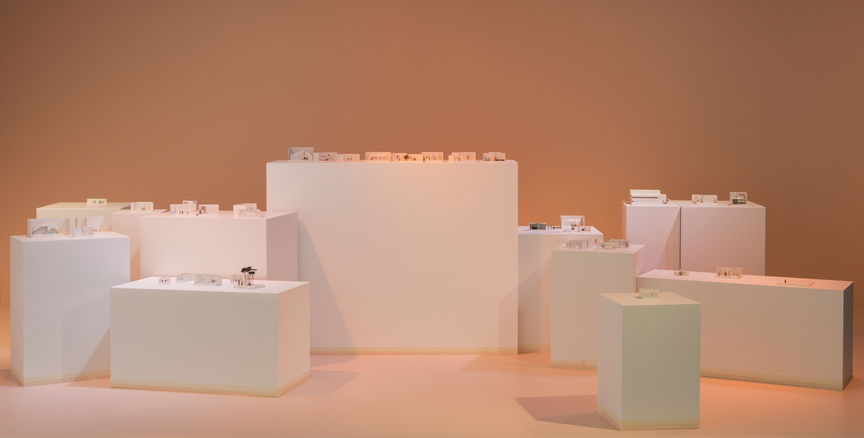-
From Current Issue
-
- Editor’s Letter Fire in the Heart
- Reviews I Gusti Ayu Kadek Murniasih
- Reviews 11th Seoul Mediacity Biennale: “One Escape at a Time”
- Dispatch Networked China
- One on One Monira Al Qadiri on Yukio Mishima
- Essays The rise of independent art spaces in pandemic-era Shanghai
- Features Tuan Andrew Nguyen
- Table of Contents
- Web Exclusives
- Archive
- Subscribe

R
E
V N
E
X
T
Installation view of ALA YOUNIS’s “Steps Toward the Impossible” at Sharjah Art Foundation, 2018. Courtesy Sharjah Art Foundation.
Every life is a performance of social and political actions signaling affiliation—or lack thereof—with a group, be it an ideology, a culture, nation or creed. In Ala Younis’s solo show at the Sharjah Art Foundation, “Steps Toward the Impossible,” performance as an embodied practice was explored through a survey of her work over the past ten years, with each installation considering how objects and actions replicate or resist ideology. The impossibility of fully realizing the optimistic visions bound up in these ideals was woven through the pieces, via the narratives of individuals and societies grappling with the effects of ideological yearning.
Installation view of Ala Younis’s Nefertiti (detail), 2008, five sewing machines and wood, 120 × 27 × 42 cm, with video: 11 min 30 sec, at “Steps Toward the Impossible,” Sharjah Art Foundation, 2018. Courtesy Sharjah Art Foundation.
The exhibition opened with Younis’s acclaimed video and installation of five vintage sewing machines, Nefertiti (2008), a research project into the titular brand of sewing machines as a locus for the collective memory of anticipation and pride following the Egyptian Revolution of 1952, which marked a political and cultural turn away from the West in favor of a distinctly Egyptian national identity. In the documentary-style film, Younis searches for traces of the Nefertiti sewing machine, an emblem of Egyptian historical might branded with Nefertiti’s the eponymous queen’s visage—a product of Egyptian president Gamal Abdel Nasser’s efforts to support local industry and enlist members from all levels of society, including housewives, to build a strong, independent Egyptian society. Through overlapping archival footage and the artist’s recordings of interviewees reminiscing about the iconic sewing machine, Younis’s film shows how the Nefertiti functioned as a symbol of Arab nationalism, modernity and female labor. The machine’s use thus reinforced revolutionary ideals, until its design flaws rendered it obsolete. The film is a wistful meditation on a moment in time captured within an everyday object, and its ideological and emotional significance in the collective lives of the people who owned it.
In the installation Tin Soldiers (2011), Younis cast toy soldiers to represent the nine armed forces—of Egypt, Iran, Iraq, Israel, Jordan, Lebanon, Palestine, Syria and Turkey—that have reshaped the Middle East through the wars of the 20th and 21st centuries. Placed equidistant from one another on a 3.5-meter plinth at a 1:200 scale, the 12,261 soldiers symbolize the inherited militarism of the region after the resistance against colonial powers in the 20th century evolved into more complex, ongoing conflicts. As stated in the exhibition catalogue, during the peak of tin soldier production in Europe and North America, between the two World Wars, the Middle East’s unstable borders were being remapped by Western powers, which subsequently omitted the struggle and sacrifice of Middle Eastern soldiers during this period in their historical narratives.
Installation view of ALA YOUNIS’s Enactment, 2017, graphite on paper and inkjet prints, dimensions variable, at “Steps Toward the Impossible,” Sharjah Art Foundation, 2018. Courtesy Sharjah Art Foundation.
For the project Enactment (2017), laid out as a narrative along the back wall of the gallery, Younis had set out to research the early history of performance art in the Middle East but instead began to uncover similarities between the concepts of physical gesture as art and of political resistance as an embodied ideological statement. Through mapping the physicality of resistance through images of protest, drawings and diagrams of bodies in motion, and written cues for movement and blocking, Younis suggests that all deliberate action is performance, blurring the distinction between the aesthetic and the political.
In her new installation Drachmas (2018), tiny white-box style architectural models of TV sets were laid out across a series of plinths. Populated with small plastic figures posed in domestic scenes, these models reference the rise of the highly mobile Arabic-language television industry since the 1960s. Due to the unstable political climates of the cities in which productions were filmed, shoot locations often changed at short notice, and studios had to accommodate multiple productions of different settings and genres. The industry’s ability to adapt to shifting circumstances is a fitting metaphor—while places may evolve with changing political tides, the narrative of daily life continues. It is a poignant representation of how identity endures within the people who embody and perform it every day, despite the chaos of the world that surrounds them.
Ala Younis’s “Steps Toward the Impossible” is on view at Sharjah Art Foundation until January 5, 2018.
To read more of ArtAsiaPacific’s articles, visit our Digital Library.















